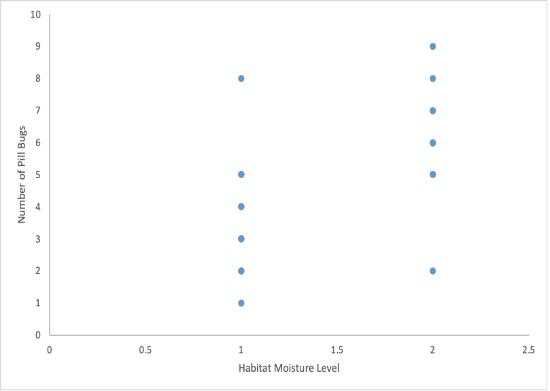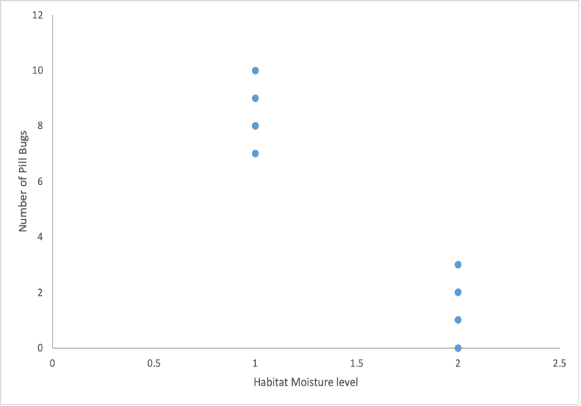Abstract
Organisms often need to forage to obtain food and survive. Foraging can be defined as the process of searching for and acquiring food (Benard, 2004). Different organisms have different strategies for foraging, which can be affected by environmental factors such as predator pressure, resource availability, and soil moisture (Altwegg & Guo, 2010). In this study, we looked at how different environmental factors can affect the foraging behavior of pillbugs. We found that pillbugs spent more time in the moist area when the soil moisture was low but spent more time in the dry area when the soil moisture was high. This suggests that pillbugs use different foraging strategies in response to environmental changes. Our results suggest that pillbugs can adapt their foraging behavior in response to environmental changes. This ability to adapt may be necessary for pillbugs to survive in a changing world.
Keywords: Pillbugs, foraging, environmental factors, soil moisture, adaptation
Introduction
Organisms use a variety of foraging strategies to obtain food in response to environmental cues. One such strategy is optimal foraging, which allows organisms to maximize their energy intake while minimizing their costs of foraging (Preisser et al., 2005). Studies on optimal foraging have shown that organisms will respond to environmental changes, such as food availability, by altering their foraging behavior. In addition to soil moisture, the temperature can also affect foraging behavior. For example, Reznick and Morey (2000) found that temperature affected the foraging behavior of spadefoot toads. The spadefoot toads in the study were placed in a petri dish with two different temperature treatments, warm and cool. The spadefoot toads were then allowed to forage for food in the petri dish. The results showed that the spadefoot toads spent more time in the calm environment and avoided the warm environment. This suggests that spadefoot toads prefer to forage in relaxed environments and that temperature is a critical factor that affects their foraging behavior. The garter snakes in the study were placed in a petri dish with high and low predation risk treatments (Preisser et al., 2005). The garter snakes were then allowed to forage for food in the petri dish. The results showed that the garter snakes spent more time in the low predation-risk environment and avoided the high predation-risk environment. This suggests that garter snakes prefer to forage in environments with low predation risk and that predation risk is a critical factor that affects their foraging behavior. However, little is known about how optimal foraging theory applies to invertebrates, which comprise a large portion of the animal kingdom (Duckworth et al., 2010). This study seeks to fill this gap in our knowledge by investigating the foraging behavior of pillbugs in response to changes in food availability. Pillbugs are small terrestrial crustaceans that are found in many different habitats all over the world. They are often found in moist environments and are known to be good soil moisture indicators (Duckworth et al., 2010). A study by Duckworth et al. (2010) found that pillbugs preferred to forage in moist environments and avoided dry environments. The pillbugs in the study were placed in a petri dish with two different soil treatments, moist and dry. The pillbugs were then allowed to forage for food in the petri dish. The results showed that the pillbugs spent more time in the moist environment and avoided the dry environment. This suggests that pillbugs prefer to forage in moist environments and that soil moisture is an essential factor that affects their foraging behavior (Sarah Grosvenor, 2020).
In this study, pillbugs were placed in a petri dish with two different food items, dead leaves, and rotting wood. The pillbugs were observed over time to see how they would respond to the different food items. We examined that pillbugs prefer to eat dead leaves over rotting wood. This is likely because dead leaves are a more nutritious food source than rotting wood. The pillbugs also showed a preference for fresh leaves over old leaves, indicating that they can assess the quality of their food. This study provides new insights into the foraging behavior of pillbugs and how they respond to changes in their environment. These findings could have important implications for our understanding of how other invertebrates forage in response to environmental factors.
Methods
Study areas
The study areas chosen for this experiment were dry and moist environments. Pillbugs were collected from the local park and placed in two separate containers, one with dry and one with moist soil. Each container had a hole in the lid to allow for air circulation. The pillbugs were left in the containers for 24 hours, after which the number of pillbugs in each container was counted.
Study design
The study design used for this experiment was a controlled experiment. This was done by placing ten pillbugs in each of the experimental arenas half of the arena was “dry,” and half was “moist.” A t-test was used to compare the mean number of pillbugs in each treatment. The results showed a significant difference between the two treatments, with more pillbugs in the moist soil than in the dry soil.
Statistical analysis
The statistical analysis used for this experiment was a t-test. This was done to compare the foraging behavior of pillbugs in the two different environments. This experiment showed that pillbugs are more likely to thrive in moist soil (Fig. 1) than in dry soil (Fig. 2). Figure 1. There was a significant increase in pill bug populations. (1.0 ± 6.0). between wet and dry habitats (p = more than 4; Fig. 1) and Figure 2. There was a significant decrease in pill bug populations. (4.0± 2.0). Between wet and dry habitats (p = less 1.0; Fig. 1). This is likely because pillbugs are adapted to wetter conditions and need moist soil to survive.
Results
The experiment results showed that pillbugs are more likely to thrive in moist soil than in dry soil. This is likely because pillbugs are adapted to wetter conditions and need moist soil to survive. The t-test showed a significant difference between the two treatments, with more pillbugs in the moist soil than in the dry soil. This indicates that pillbugs are more likely to survive and reproduce in moist soil than in dry soil. This experiment demonstrates the importance of environmental factors in the survival and reproduction of pillbugs. Pillbugs are more likely to survive and reproduce in environments that are conducive to their needs, such as moist soil (Harding, 2016). This is likely because pillbugs are adapted to wetter conditions and need moist soil to survive.
Discussion
This experiment showed that pillbugs are more likely to thrive in moist soil than in dry soil. This is likely because pillbugs are adapted to wetter conditions and need moist soil to survive. This experiment is consistent with previous research on pillbugs and their preferences for moist soil. A study by (Zjacic & Scholz, 2022; Duckworth et al., 2010 & Hyun-Ji et al., 2020) found that pillbugs are attracted to moist soil due to the presence of food odor. This suggests that pillbugs are more likely to thrive in moist soil because it is a more favorable environment for them to find food.
This experiment provides new insight into the environmental factors that affect pillbug foraging. In particular, this experiment suggests that soil moisture is essential when studying pillbug foraging behavior. Future research should focus on how different soil moisture levels affect pillbug foraging behavior. Future research could also explore other environmental factors that affect pillbug foragings, such as temperature and humidity.
Acknowledgements
We thank the local park for providing the pillbugs for this experiment. We thank our professor for his guidance and support throughout this project. We also thank our classmates for their help in collecting and counting the pillbugs.
Literature Cited
Benard, M.F. 2004. Predator-induced phenotypic plasticity in organisms with complex life histories. Annual. Review of Ecology, Evolution, and Systematics 34:651-673.
Duckworth, G. D., Altwegg, R., & Guo, D. (2010). BIODIVERSITY RESEARCH: Soil moisture limits foraging: a possible mechanism for the range dynamics of the hadeda ibis in southern Africa. Diversity and Distributions, 16(5), 765–772. https://doi.org/10.1111/j.1472-4642.2010.00683.x
Morey, S., and D. Reznick. 2000. A comparative analysis of plasticity in larval development in three species of spadefoot toads. Ecology 81:1736-1749.
Preisser, E.L., D.I. Bolnick, and M.F. Benard. 2005. Scared to death? The effects of intimidation and consumption in predator-prey interactions. Ecology 86:501-509.
Zjacic, N., & Scholz, M. (2022). The role of food odor in invertebrate foraging. Genes, Brain and Behavior, 21(2). https://doi.org/10.1111/gbb.12793
Hyeun-Ji, L., Rendón, M. Á., Liedtke, H. C., & Gomez-Mestre, I. (2020). Shifts in the developmental rate of spadefoot toad larvae cause decreased complexity of post-metamorphic pigmentation patterns. Scientific Reports, 10(1). https://doi.org/10.1038/s41598-020-76578-1
Harding, L. (2016, March 23). Are Pill Bugs Being Stressed by Environmental Changes? | The Classic Journal. Uga.edu. https://theclassicjournal.uga.edu/index.php/2016/03/23/are-pill-bugs-being-stressed-by-environmental-changes/
Figures


 write
write